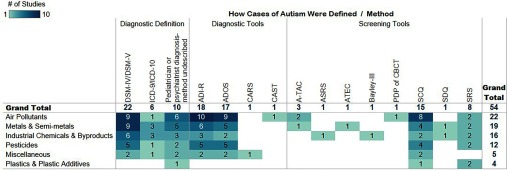Figure 3.
Heat map of included epidemiological studies by exposure (in rows) and how autism was determined within the study (in columns). Numbers within cells indicate the number of studies for a given exposure and method of autism determination. Empty cells indicate a lack of studies. An interactive version of this figure is available at https://public.tableau.com/profile/the.endocrine.disruption.exchange#!/vizhome/Fig3_Enviornmentalchemicalsandautism-epidemiologicaldata/Interactive. For clarity, the different methods of autism determination were collapsed into the following broad categories: used specific diagnostic tools, used specific screening tools, and/or stated that children met either the DSM or ICD criteria. It should be noted that diagnostic tools and screening tools are used by practitioners to reach a DSM or ICD diagnosis, but stating that a DSM or ICD diagnosis was given does not indicate which specific tools were used to reach that conclusion. The 142 specific exposures assessed in the included studies were also collapsed into six broad categories for improved clarity. The categories for types of exposures can be fully expanded in the interactive version of the figure. Additional study information can be found in the interactive Figure S1 and in Excel Table S3. Note: A-TAC: autism tics, ADHD, and other comorbidities inventory; ADIR-R, Autism Diagnostic Interview–Revised; ADOS, Autism Diagnostic Observation Schedules; ASRS, Autism Spectrum Rating Scales; ATEC, Autism Treatment Evaluation Checklist; CARS, Childhood Autism Rating Scale; CAST, Childhood Autism Spectrum Test; DSM, Diagnostic and Statistical Manual of Mental Disorders; ICD, International Statistical Classification of Diseases and Related Health Problems; PDP of CBCT, Pervasive Developmental Problems subscale of the Child Behavior Checklist for Toddlers; SCQ, Social Communication Questionnaire; SDQ, Strengths and Difficulties Questionnaire; SRS, Social Responsiveness Scale.

